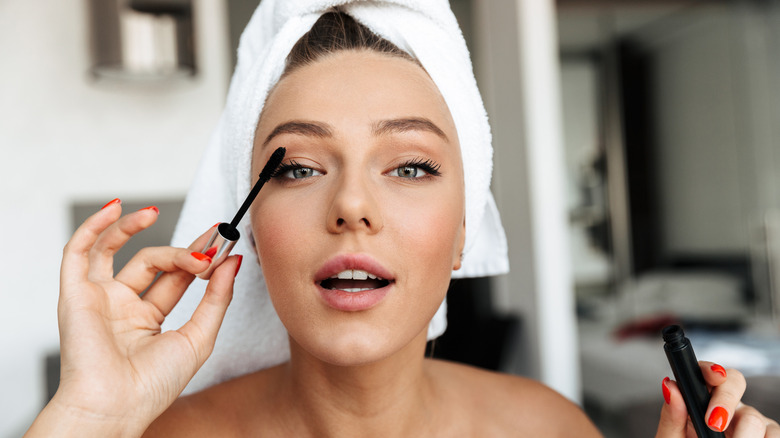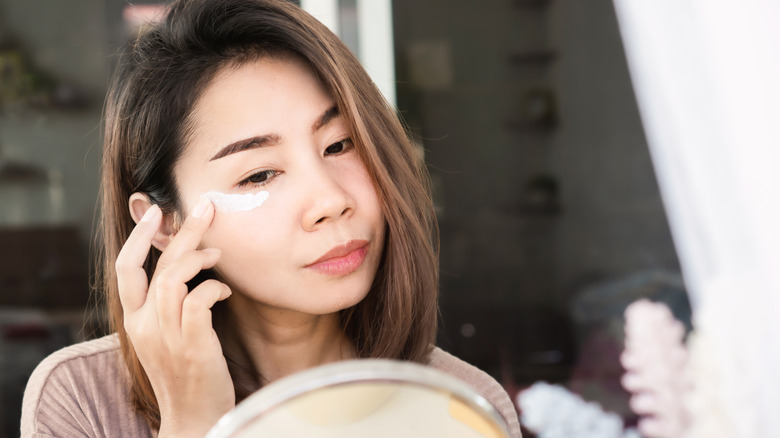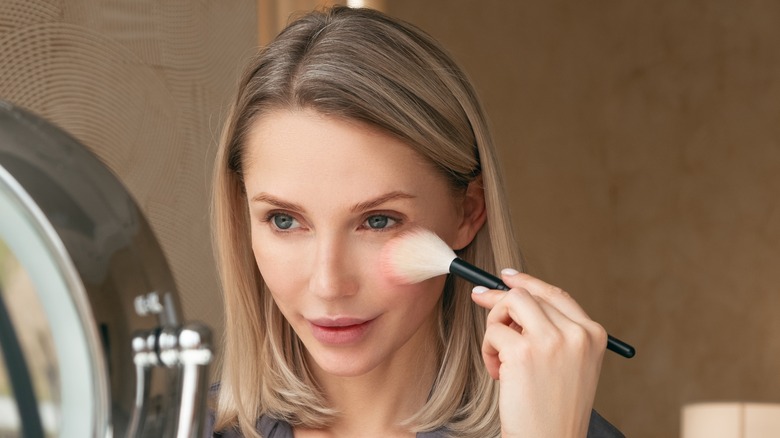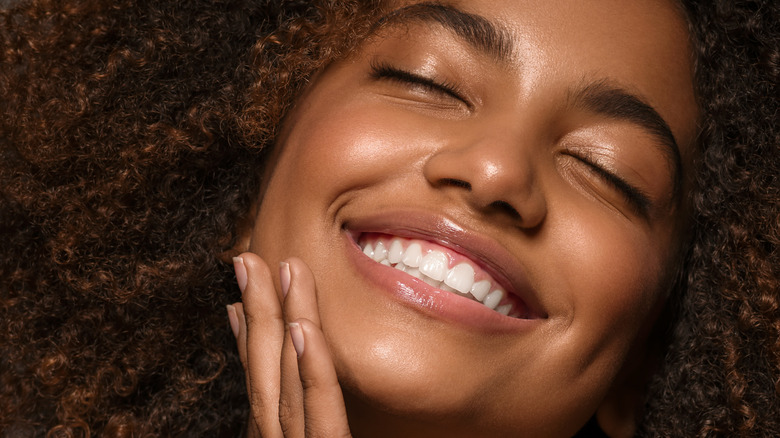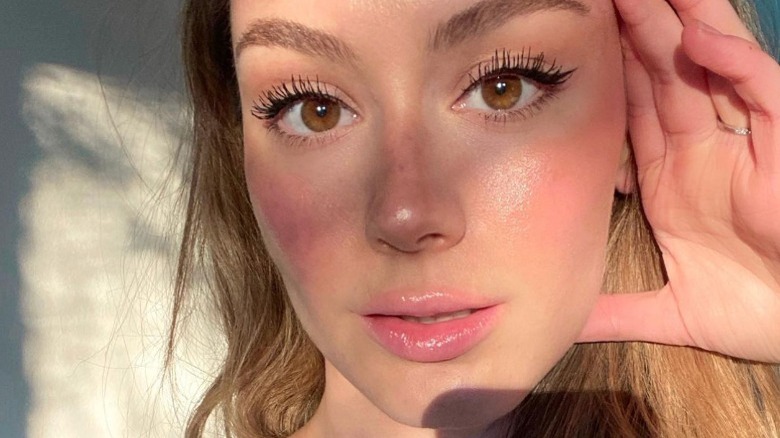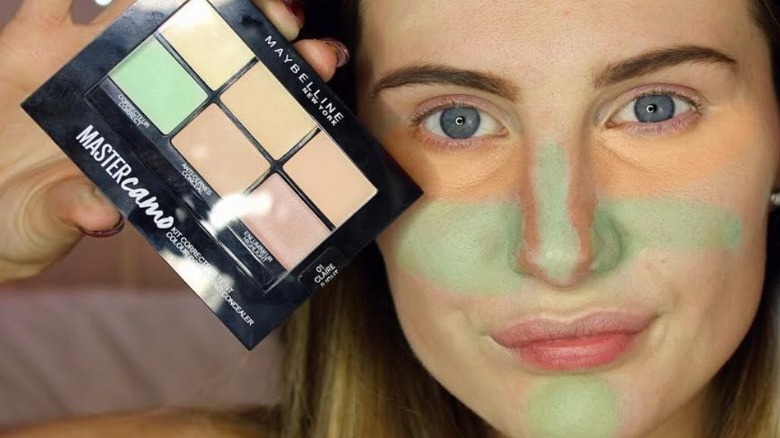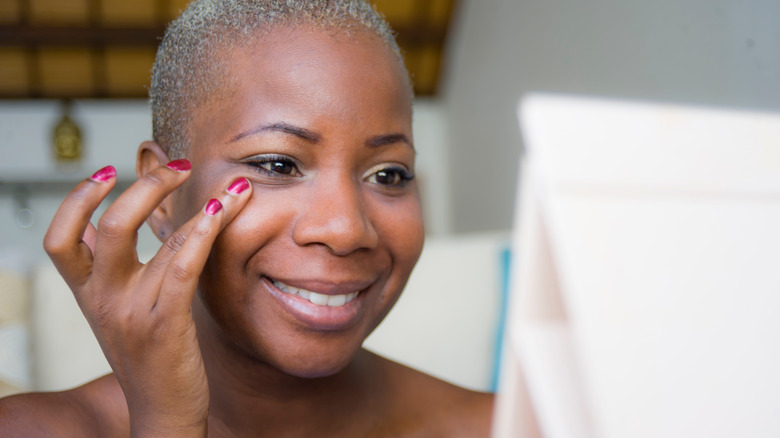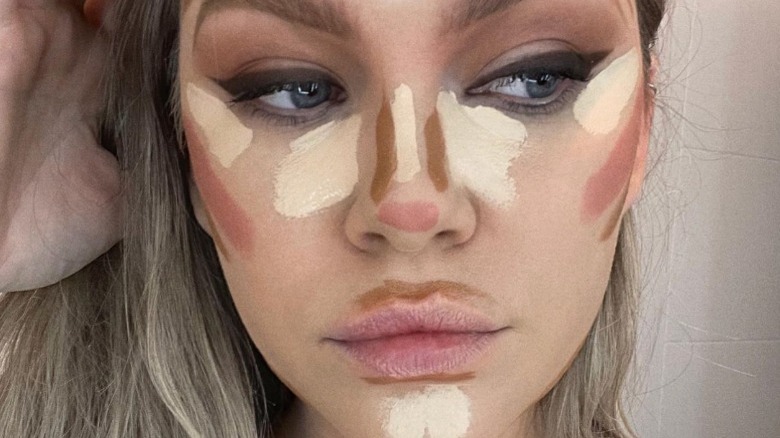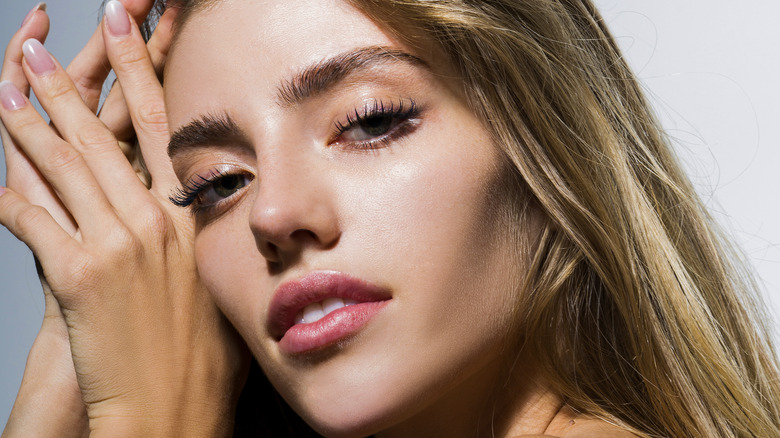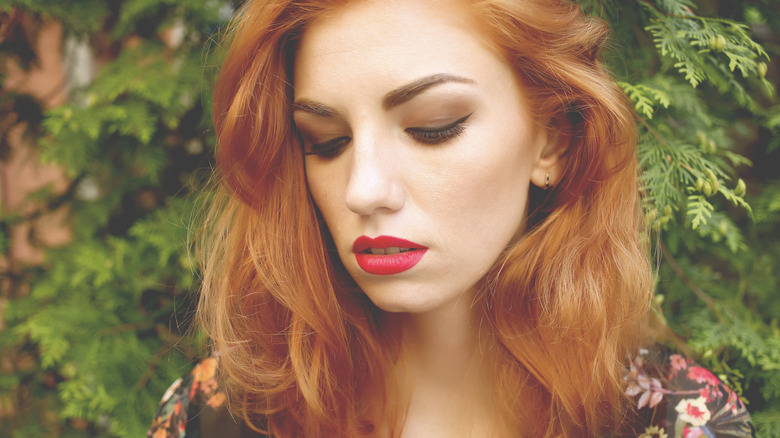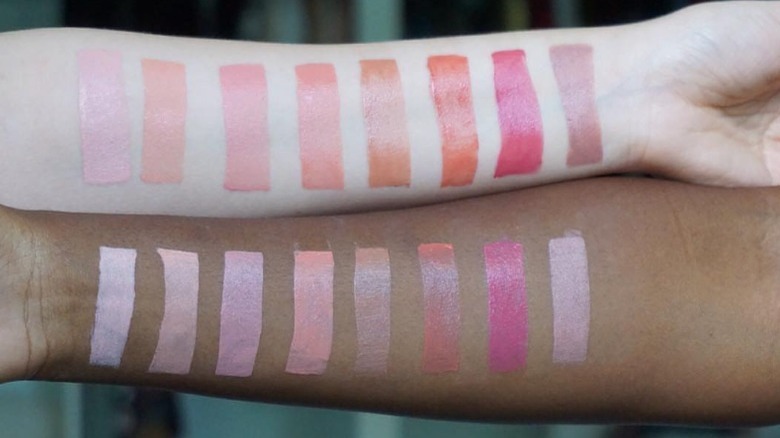Everything You Need To Know About Changing Up Your Makeup In Your 30s
Aging is beautiful, and the process of growing older is a privilege worth embracing. Of course, it can also come with a few beauty-related hiccups, particularly regarding the makeup you wear. You still want your makeup to look flattering when you wear it. But it can be a pain to find that the makeup you've used and loved for more than a decade begins to sit differently on your skin. Suddenly there are spots, wrinkles, or fine lines in places where there used to be nothing at all, and makeup creases or settles heavier than you'd like it to.
Like most people, you may have to change up your makeup in your 30s, which is "the age of less is more," according to makeup artist Ruby Hammer. "You know what you are doing right," she tells The Telegraph. "Just don't get into a rut and keep doing the same face ... this ages you before your time." Paying special attention to your skincare and keeping your makeup looks light and as natural-looking as possible will help you enhance your beauty and age gracefully.
Prioritize skincare
Before you head to Sephora for a new batch of makeup, you need to think about proper skincare. "Your 30s are a time of ... stress and hormonal swings that can wreak havoc on your skin," celebrity esthetician Renée Rouleau tells Byrdie. "The growth hormones start to slow down, so the skin won't repair itself as it did in your 20s; breakouts can often occur in the form of cystic acne. It's time to take your skin seriously. The days of neglecting your skin are over." In addition to changes in your complexion, fine lines, wrinkles, and dark spots may become an issue, all of which can be combated with the right skincare products.
First things first, you should ditch the makeup wipes and invest in a quality cleanser. "Wipes are too abrasive for your skin in your 30s," skin expert Lorraine Scrivener tells Women's Health. "They might also contain alcohol to remove makeup quickly, which can disturb your skin's natural barrier function, leading to sensitivity and dehydration." You should also consider a daily eye cream, moisturizer, retinoid cream or serum, and SPF to combat common signs of aging.
It is never too late to prioritize skincare, no matter how old you are. By taking care of the skin on your face and neck and addressing their needs in your 30s, you can brighten, hydrate, and hit the pause button on the less lovable signs of aging for a while longer.
Keep your skin hydrated
If you want your makeup to look flawless as you enter your 30s, you need to hydrate the skin properly. Even if you've never experienced dry skin before, as you age, your skin may become dry and flaky due to decreased sebum production and cell renewal. Moisturizing ensures the outermost layer of your skin has the moisture it needs to carry necessary nutrients to the skin's cells while also flushing away toxins and bacteria. It also keeps it looking and feeling smooth.
If you have yet to enter your 30s, you may have a moisturizer that you swear by. However, with your skin's natural changes as you age, you may need to upgrade to something with a little more hydrating power. Dermatologist Kristina Collins, MD, tells Glamour that moisturizers best suited for mature skin should include "strong hydrators like hyaluronic acid, antioxidants, and vitamin A derivatives or peptides." This anti-aging combo will help your skin hold onto water and give a plump, smooth effect.
The adage "beauty starts from the inside out" has truth to it. The National Institute on Aging notes that protecting your skin from UV rays, staying hydrated, and daily moisturizing are key to achieving beautiful skin. Plus, there are ways to keep your skin healthy and moisturized without using lotion. Eating foods rich in fatty acids like walnuts, salmon, and oils like avocado or olive can help maintain your skin's hydration levels. You should also aim to drink between 11.5 to 15.5 cups of fluids daily.
Less is more
Once you've got your skincare routine locked down, you can start thinking about makeup and finding the best products for your skin. Your 30s come with a new host of skin issues to contend with, from fine lines and larger pores to uneven texture. As a result, caking on multiple layers of foundation, concealer, and powder may not be the best option anymore. Adopting a "less is more" philosophy when it comes to your makeup is key.
"Fine — or not so fine — lines and larger pores can make foundation look mask-like at best and incredibly unflattering at the worst," makeup artist Fiona Stiles tells Allure. "Finding a [hydrating] foundation that melts into the skin is paramount for looking fresh. Anything too heavy will settle into lines and do the opposite of what you're looking for."
You should also aim for high-quality makeup products that can help you achieve a flawless, glowing complexion. Focus on applying your makeup with a lighter hand as well. This will ensure that your makeup isn't heavy enough to settle into creases and wrinkles on your skin. As an added benefit, a less is more makeup routine is lower maintenance and takes significantly less time to apply.
Opt for sheer coverage
While you may be tempted to reach for a full-coverage foundation to cover up any imperfections, this often leads to the cakey look you want to avoid. Not to mention those formulas can make you appear older than you actually are if applied incorrectly. Instead, a sheer-coverage foundation is a better option. "Mature skin needs a lightweight foundation that has reflective qualities and is hydrating," celebrity makeup artist Autumn Moultrie tells Glamour. "Reflective qualities in a foundation deflect wrinkles and add a glow — that, sadly, is lost over time because of a diminished cell turnover rate."
It may seem counterintuitive to apply makeup that doesn't hide your "flaws," but sheer, light-coverage foundations actually enhance your natural beauty. "Your freckles will show through, your pores won't be clogged — It's for someone who maybe doesn't like the way makeup feels on their skin," renowned makeup artist Carl Ray explains to Well+Good.
Foundations with the sheer, minimal coverage look can be found in BB creams and CC creams. Tinted SPF products are also a great option that doubles as your makeup base and your sun protection. It is recommended that people with more mature skin look for foundations that provide the complexion with a more natural, dewy finish as well.
Use cream blush and bronzer to fake a youthful glow
You may be thinking: What about contouring? Do you need to ditch these face-sculpting makeup tools for a lighter, more natural look as well? While you don't have to skip blush and bronzer entirely, you may want to consider swapping out the powders you currently use for creams. Cream blush provides a youthful, rosy bloom of color on the cheeks that appears to come from within. In other words, it has a more natural, dewy look than powder blushes which can be easily overdone if you have an unpracticed hand.
Cream blush can be applied directly to the cheeks beneath your foundation to help control the pigment's intensity. Or, it can be placed on top of the foundation for a brighter glow. To properly apply cream blush, simply apply a small amount to the tip of your finger and tap the product from the top of the temple down the cheekbone. Continue blending with your fingertips, applying more color on the apples of your cheeks, and diffusing up in the temple.
Cream bronzer can be used in a similar fashion. As the skin ages, it loses its elasticity, which can lead to looser-looking skin. Bronzer not only gives the skin a sun-kissed warmth, but it helps give your face stronger angles and gives the appearance of younger-looking skin. Cream bronzers also often contain hydrating ingredients that are simultaneously good for your skin and melt into it for a smoother, more natural look.
Use a color corrector for dark circles
Dark circles around the thin skin of the eyes often become more prominent as you move through your 30s. Sometimes it feels like every missed moment of sleep or second of stress shows up on your face in ways it just didn't before. Instead of reaching for a thick, heavy concealer, using a color corrector can help erase the bruised half-moons hanging from your lower lashes.
Color correcting is a technique makeup artists use to cancel out the color of blemishes or dark circles. It utilizes colors opposite from one another on the color wheel to cancel out those dark circles and is much lighter than a matching, pigmented concealer. "When you don't want to cake on concealer to cover dark circles, color correcting will be your best friend," makeup artist Janice Kingo tells Who What Wear. "It is a way to instantly neutralize discoloration, dark circles, and blemish marks underneath your foundation/concealer."
For example, applying a concealer with a green tint on top of red pimples minimizes their look. Dark circles range in color from bluish-purple to brown or black, depending on your skin tone. An orange color corrector can help those with deep skin tones cover up dark under-eye circles, while lighter skin tones may opt for a peachy-pink color corrector. If your under-eye circles are purple in color, consider a yellow spot concealer to help cancel the colors out.
Fill in fine lines and pores with primer
The natural way skin ages makes achieving a smooth base for a seamless makeup application difficult. Luckily, you can fake an even complexion by applying a makeup primer to clean skin before doing your makeup.
Makeup primer is a cream-based product that helps prep the skin for makeup and serves as a foundation for your foundation. It is the equivalent of putting primer on a wall before painting it or gesso on a canvas. Primer helps the skin look smoother thanks to the presence of silicone-based polymers that fill lines, divots, and depressions in the skin from acne scarring or large pores. The layers of makeup that go on top of the primer base will not only look better, but they will also last longer. Its presence can prevent creasing and help control oil and shine.
There are a number of different types of primers to choose from, all of which serve different skin and makeup purposes. People in their 30s should opt for hydrating primers with hyaluronic acid to combat dry, flaky skin that can make makeup look worse. Blurring primers are also an excellent option for mature skin as they tone down the appearance of pores and an uneven complexion.
Don't overdo it on the concealer
Traditional concealers are often heavy and thick, which are great when you're 22 and in need of something to hide the hangover-induced eye circles ringing your eyes. But, similar to how your foundation needs to change in your 30s, so will your concealer. If the formula is too heavy or pigmented, it will settle and crease into the areas you are trying to cover up. Therefore, it is important to find a concealer specifically designed for wrinkles and fine lines.
"When it comes to concealers for mature skin, liquid and creams are best as they contain hydrating properties to help decrease the look of lines and hyperpigmentation," Kim Baker, celebrity makeup artist and founder of Glamazon Beauty, tells Southern Living. "Less is more when it comes to wearing concealer. Blending and layering are key, and I also set the concealer with a translucent powder when finished."
Try concealers with a brighter shade to keep the skin looking fresh and glowy, and look for products that contain hyaluronic acid. Make sure to always prep the skin with proper cleansing, priming, and moisturizing products before applying any concealer.
Keep your brows natural
In addition to natural-looking skin, people in their 30s should skip over-tweezing and over-shaping their brows and aim for full, natural-looking ones instead. During your 30s, the hair of your eyebrows naturally begins to thin. Left to their own devices, thin brows may lend a severe look to mature skin, while unkempt brows can poorly frame the face.
The good news? It's possible to regrow your eyebrows after years of over-plucking. In the meantime, you can keep some definition to the brows and your face by lightly filling in your brows with a pencil or gel, and moving the hairs in an upward motion to help give a natural, fluffy appearance without overdoing it.
"When it comes to adding volume and depth, you want to maintain that natural appearance that complements the face," brow expert Cheryl Renella tells Women's Health. "Accomplish this by staying closer to your natural color. Tinting is a great option for women at this age because it's low maintenance and it darkens brows semi-permanently."
Ditch shimmery eyeshadows for matte finishes
Shimmery eyeshadows, with their tiny particles of embedded glitter, are a lovely addition to a glamorous makeup look. As pretty as they are, the gleaming sparkle of shimmer or metallic eyeshadow colors tend to creep into the fine lines and creases of the skin around the eyes, particularly as you age and those fine lines naturally deepen. The resulting effect can be slightly less glowing goddess and a little more wrinkly mess.
Instead of shimmery makeup products, try experimenting with a more gentle sheen or (preferably) matte finish. "Shimmer has glittery sparkles in it, while a sheen has very subtle mica that glows without sparkling," makeup professional Lilit Caradanian tells Today. This glow not only settles less obviously in cracks and crevices you don't want it to, but it also allows the completed makeup look to have a natural, lit-from-within shine that is very youthful.
Matte finishes, which have a flatter texture, provide a satin finish and offer opaque, saturated color that can build up specific eye makeup looks. They are often highly pigmented and blend well with the right tools. Matte finishes look especially nice in neutral colors but can offer an exciting pop of color to the right outfit.
Pick colors that suit your skin tone
By the time most women enter their 30s, they've experimented with makeup long enough to know what colors look best on them and which ones are better suited for their Halloween costumes. While there are absolutely zero rules dictating that you must wear only neutrals the moment you turn 30, and you should always wear whatever colors make you feel beautiful, everyday makeup looks are often better suited to colors that flatter your skin tone.
If you aren't sure what makeup will best match your skin, first determine what your undertone is. This is the hue that comes through your skin and ultimately determines its overall color. You can generally identify your skin's undertone by looking at the veins on your wrist. If they are a greenish color, you have warm tones. Purple or blue veins indicate that you have cool tones. Shades of pink, plum, or blue-red typically flatter cool undertones well, while peaches, oranges, and corals look lovely with warm undertones.
Understanding your specific undertones can help you choose the right color foundation, blush, and bronzer, particularly if you experience changes in your skin as you age. No matter what makeup you choose, your personal preferences — from your clothes to the shade of lipstick you wear — are all about what makes you feel like your best self. Always go with what colors bring you joy and what looks make you the happiest.
